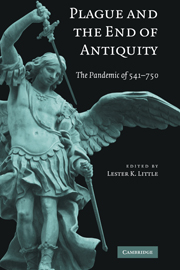Book contents
2 - Historians and Epidemics
Simple Questions, Complex Answers
Published online by Cambridge University Press: 05 June 2012
Summary
In this essay, I pose some questions that historians ask when they examine particular past epidemics or groups of epidemics, and I review some of the answers found in response to those questions. At some points, I even suggest their possible application to the Plague of Justinian. Most of the questions have been simple and obvious ones, but the answers, in some cases, have been complex and ambiguous; some of the complexities stem from historical uncertainty about whether disease should be constructed biologically or socially, a dilemma that the historiography of epidemics reflects. Different civilizations have reached different understandings of the general nature of disease. Modern historical writing, however, has reflected two relatively recent such understandings: the biological, reductionist view that rose to dominance in the late nineteenth century, and the more recent conviction that diseases are social constructs. Those two (at times conflicting) understandings now set the questions that historians of disease attempt to answer. Because disease is, in part, a “biological process,” as Henry Sigerist defined it in 1943, questions about past epidemics have included “what was the disease” (in a biological, ontological sense), what were its physical effects, how did it spread, how many died or were sickened by it. Convictions that diseases are social constructs have led to other questions: “What did the society make of it?” and “How did the society confront it or perhaps even use it?”
- Type
- Chapter
- Information
- Plague and the End of AntiquityThe Pandemic of 541–750, pp. 33 - 56Publisher: Cambridge University PressPrint publication year: 2006
- 1
- Cited by

